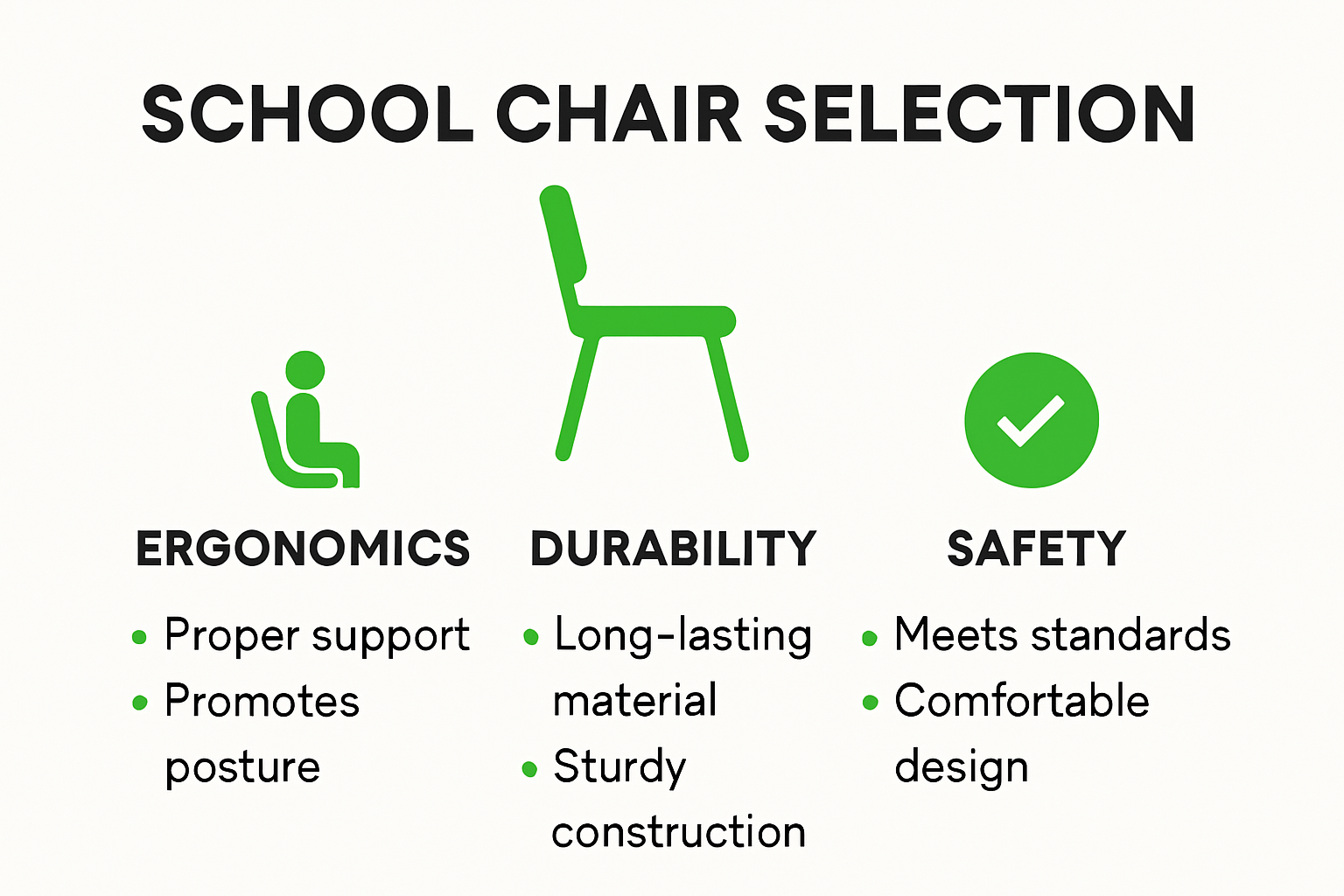School Chairs for Businesses and Schools in South Africa 2025
Jul 13, 2025
School Chairs for Businesses and Schools in South Africa 2025

School chairs might look like simple plastic and metal, but their impact goes way beyond just giving kids a place to sit. Here’s something your teachers probably never mentioned. Up to 80 percent of high school learners in Cape Town sit in chairs that do not fit them at all. Sounds like a recipe for discomfort, right? Here’s the catch. The biggest classroom gains actually start with the right chair because small changes in seating can drive better focus, health, and real improvement in how kids learn.
Table of Contents
- Choosing The Best School Chairs
- Benefits Of Quality School Chairs
- Top Trends For School Chairs In 2025
- Buying School Chairs In Southern Africa
Quick Summary
| Takeaway | Explanation |
|---|---|
| Ergonomics is Key in Chair Selection | Proper ergonomics is crucial for ensuring student comfort, preventing musculoskeletal issues, and supporting diverse student sizes through adjustable designs. |
| Quality Chairs Boost Academic Performance | Ergonomically designed chairs enhance students’ focus, reduce physical distractions, and positively impact their cognitive engagement during lessons. |
| Sustainability is a Growing Trend | Increasingly, manufacturers are using eco-friendly materials, such as recycled plastics and locally sourced wood, to create sustainable school furniture. |
| Compliance with Regulations is Essential | Educational institutions must adhere to local procurement policies and SABS standards to ensure the safety, durability, and quality of school chairs. |
| Flexible Configurations Enhance Learning Spaces | Modern chairs are adaptable and modular, allowing for dynamic learning environments that cater to various educational activities and styles. |
Choosing the Best School Chairs
Selecting the right school chairs is a critical decision that impacts student comfort, learning efficiency, and long-term physical health. The process involves careful consideration of multiple factors to ensure optimal ergonomic support and functionality for educational environments.

Ergonomic Considerations for Student Seating
Ergonomics plays a crucial role in school chair selection. Research conducted in the Cape Metropole revealed a startling statistic: 65% to 80% of high school learners did not match the dimensions of their existing computer laboratory chairs. This mismatch can lead to significant discomfort and potential long-term health issues.
Key ergonomic factors include seat height, back support, and overall chair dimensions. Students spend considerable time seated, making proper support essential for preventing musculoskeletal problems. Adjustable chairs become particularly important, as they can accommodate the varying sizes of students across different age groups and grades.
Safety and Regulatory Compliance
The South African Department of Basic Education has established comprehensive School Furniture Specifications aligned with the South African Bureau of Standards (SABS). These guidelines ensure that school chairs meet critical safety and durability requirements.
Additionally, the Department of Employment and Labour’s Ergonomics Regulations mandate programs to control ergonomic hazards in workplace and educational settings. This regulatory framework emphasizes the importance of selecting chairs that protect students’ physical well-being.
Material and Durability Considerations
School chairs must withstand significant daily use and potential rough handling. The ideal chair combines durability with comfort, typically featuring robust materials like high-quality plastics, reinforced metals, or specially treated wood. Considerations should include resistance to wear and tear, ease of cleaning, and ability to maintain structural integrity under constant use.
When choosing school chairs, educational institutions should prioritize:
- Adjustability: Chairs that can accommodate different student sizes
- Durability: Materials that can withstand daily classroom environments
- Comfort: Ergonomic design that supports proper posture
- Safety: Rounded edges and stable construction
By carefully evaluating these factors, schools can select chairs that not only meet regulatory requirements but also create a comfortable and supportive learning environment. Office Stock specializes in providing comprehensive school furniture solutions that address these critical considerations, ensuring students have the best possible seating support throughout their educational journey.
Here is a table summarising the key criteria for selecting quality school chairs, as discussed above:
| Criteria | Why It Matters | Example Features |
|---|---|---|
| Adjustability | Fits diverse student sizes for various ages/grades | Height-adjustable seat, movable backrest |
| Durability | Withstands daily use and rough handling | Reinforced metal frame, impact-resistant plastic |
| Comfort | Prevents musculoskeletal issues and discomfort | Ergonomic contour, adequate seat/back padding |
| Safety | Reduces risk of injury and ensures student safety | Rounded edges, stable base |
| Ease of Cleaning | Maintains hygiene in school environment | Smooth surfaces, wipe-clean materials |
Benefits of Quality School Chairs
Physical Health and Ergonomic Advantages
Research from academic studies reveals remarkable connections between quality school chairs and students’ physical well-being. Properly designed classroom furniture has been demonstrated to reduce back pain, decrease musculoskeletal complaints, and increase trunk muscle strength. These physical benefits are not merely comfort considerations but fundamental aspects of student health.
The significance of chair design becomes evident when examining postural implications. Experimental research highlights that seat depth and backrest height significantly interact with learning task performance. This means the right chair configuration can directly influence a student’s ability to concentrate, learn, and engage with educational content.

Academic Performance and Cognitive Impact
Contrary to traditional perspectives that view chairs as passive classroom elements, contemporary research suggests they play an active role in learning outcomes. Students seated in ergonomically designed chairs demonstrate improved on-task behavior and enhanced cognitive performance. The relationship between physical comfort and mental engagement is profound.
Chairs that provide proper support reduce physical distractions, allowing students to maintain focus for longer periods. By minimizing physical discomfort, quality school chairs create an environment where learning can flourish without the interruption of muscular strain or postural fatigue.
Long-Term Developmental Benefits
Investing in quality school chairs represents a forward-thinking approach to student development. Chairs that support correct posture during critical growth years can prevent long-term musculoskeletal issues. Young learners spending significant time seated require furniture that adapts to their changing physical needs.
The developmental advantages extend beyond immediate physical comfort. By promoting proper sitting positions and providing supportive ergonomic design, these chairs contribute to:
- Spinal Health: Reducing risks of long-term postural problems
- Muscle Development: Supporting natural physical growth
- Cognitive Engagement: Minimizing physical distractions during learning
- Psychological Comfort: Creating a sense of physical well-being
Office Stock understands that school chairs are more than furniture pieces. They are critical tools in creating supportive, health-conscious educational environments that nurture both physical and intellectual growth. By prioritizing quality, ergonomics, and student-centered design, schools can transform simple seating into powerful learning assets.
To provide a clear overview, the following table summarises the main benefits of quality school chairs for students and schools:
| Benefit | Description |
|---|---|
| Improved Physical Health | Reduces back pain, prevents musculoskeletal issues |
| Enhanced Focus & Engagement | Minimises distractions and supports better attention |
| Long-term Development | Promotes healthy posture and physical growth |
| Psychological Well-being | Increases comfort, reduces stress, improves morale |
| Cognitive Performance | Directly impacts concentration and learning outcomes |
Top Trends for School Chairs in 2025
The landscape of school furniture is rapidly evolving, with 2025 promising innovative approaches that reimagine traditional classroom seating. Educational institutions are moving beyond conventional design, embracing technological, ergonomic, and sustainability-driven solutions that transform learning environments.
Flexible and Adaptive Seating Configurations
Research from educational furniture specialists indicates a significant shift towards modular and reconfigurable seating. Modern school chairs are no longer static objects but dynamic learning tools. Stackable, mobile, and easily rearrangeable chairs enable educators to create flexible learning spaces that can quickly transition between collaborative group work, individual study sessions, and interactive presentations.
This trend acknowledges the diverse learning styles of students, providing furniture that can adapt to different pedagogical approaches. Chairs with wheels, lightweight designs, and multiple configuration options are becoming standard in forward-thinking educational settings.
Sustainability and Eco-Conscious Design
Market analysis from industry research reveals a growing commitment to environmental responsibility in school chair manufacturing. Manufacturers are increasingly utilizing recycled plastics, responsibly sourced wood, and low-impact production methods. These eco-friendly materials not only reduce carbon footprints but also provide an opportunity to educate students about sustainable practices.
Key sustainable features emerging in 2025 include chairs made from:
- Recycled Ocean Plastics: Transforming waste into functional furniture
- Locally Sourced Timber: Supporting regional manufacturing and reducing transportation emissions
- Biodegradable Composite Materials: Creating chairs with minimal environmental impact
Technology and Ergonomic Integration
Ergonomic research from South African experts emphasizes the critical role of chair design in student well-being. The 2025 trends showcase chairs that go beyond traditional ergonomics, incorporating smart technologies and advanced biomechanical principles.
Innovative features include built-in posture sensors, adjustable support mechanisms, and designs that actively promote proper spinal alignment. Some advanced chairs now include subtle tech integrations like charging ports, digital connectivity, and even minor health monitoring capabilities.
Educational institutions are recognizing that chairs are no longer mere sitting devices but comprehensive support systems for student physical and cognitive development. Read our guide on modern classroom solutions to explore how these innovative designs can transform learning environments.
By embracing these trends, schools can create dynamic, sustainable, and student-centered spaces that support holistic educational experiences. Office Stock remains committed to delivering cutting-edge school furniture solutions that meet the evolving needs of modern educational institutions.
Buying School Chairs in Southern Africa
Purchasing school chairs in Southern Africa requires a strategic approach that considers regulatory requirements, local manufacturing standards, and institutional needs. Educational institutions and businesses must navigate a complex landscape of procurement guidelines, quality specifications, and budgetary constraints.
Regulatory Procurement Framework
The Preferential Procurement Policy Framework Act mandates that government departments procure 100% of school furniture from local manufacturers. This policy supports the domestic furniture industry while ensuring that purchased chairs meet stringent national standards. School administrators must carefully verify suppliers’ compliance with local content requirements and manufacturing certifications.
The South African Department of Basic Education has developed comprehensive School Furniture Specifications aligned with the South African Bureau of Standards (SABS). These specifications outline critical requirements for durability, safety, and ergonomic design, providing a clear framework for procurement decisions.
Regional Procurement Strategies
The Western Cape Education Department provides an exemplary model for systematic furniture procurement. Their three-year furniture contract covers 31 specified school furniture items, demonstrating a comprehensive approach to meeting educational infrastructure needs. This strategy offers several key advantages:
- Standardization: Consistent furniture specifications across institutions
- Cost-Effectiveness: Bulk procurement reducing overall expenses
- Quality Control: Centralized verification of furniture standards
Institutions should consider multiple factors when purchasing school chairs, including:
- Material durability
- Ergonomic design
- Local manufacturing credentials
- Long-term maintenance requirements
Navigating Procurement Challenges
Buying school chairs in Southern Africa involves more than simply selecting furniture. Check out our comprehensive guide to school furniture selection to understand the nuanced considerations involved in making the right choice.
Key challenges include balancing budget constraints with quality requirements, ensuring compliance with local regulations, and meeting the diverse needs of different educational environments. Schools must consider factors such as:
- Age-specific ergonomic requirements
- Classroom configuration and learning styles
- Durability and maintenance costs
- Sustainability and environmental considerations
Office Stock understands the complexities of school chair procurement in Southern Africa. Our expertise helps educational institutions navigate these challenges, providing solutions that meet regulatory requirements, support local manufacturing, and create optimal learning environments.
By approaching school chair procurement strategically, institutions can invest in furniture that supports student comfort, promotes effective learning, and represents a sound long-term investment in educational infrastructure.
Frequently Asked Questions
What are the key considerations when choosing school chairs in South Africa?
When selecting school chairs, it’s essential to consider ergonomics, safety compliance, durability, and adjustability to cater to different student sizes. Chairs should also promote proper posture and be easy to maintain.
How can quality school chairs impact student learning?
Quality school chairs can significantly boost student focus and engagement. Ergonomically designed chairs reduce physical discomfort, allowing students to concentrate better, which directly enhances cognitive performance and academic outcomes.
What trends are emerging in school chair design for 2025?
In 2025, school chair design is leaning towards flexible seating configurations, sustainable materials, and technology integration. This includes modular designs that can adapt to various learning environments and the use of eco-friendly materials in manufacturing.
How do procurement regulations affect the purchase of school chairs in South Africa?
Educational institutions in South Africa must adhere to the Preferential Procurement Policy Framework Act, which requires sourcing school chairs from local manufacturers. Compliance with the South African Bureau of Standards ensures safety and quality in the furniture procured.
Upgrade Your School or Business with Seating That Supports Learning and Well-Being
Many schools and businesses struggle with uncomfortable and outdated seating, leaving students and employees unfocused, restless and more likely to experience health problems. As highlighted in our article, the wrong chair can hinder classroom engagement and even harm long-term development. But the right chair can change everything. Imagine students sitting taller, feeling energised, and able to focus throughout every lesson because their furniture is designed just for them. That is the power of choosing chairs with correct ergonomics, SABS-approved safety, and the durability needed for South African settings.

Start transforming your classrooms or offices now. Discover the difference that expertly designed, compliant and affordable seating can make by exploring the full range at Office Stock. Our team is ready to help you select the perfect solution for your learners or staff. Do not let seating hold your organisation back. Visit Office Stock today and invest in comfort, productivity and long-term success. If you need practical guidance on selecting the right school furniture, check out our school chair guide.
Recommended
- Sitemap
- Customer Support
- Zelda High-back Chair | Buy Office Chairs Online - Office Stock
- Cre8 Ergonomic Office Chair | Buy Office Chairs Online - Office Stock
- Montego Visitor Office Chair | Buy Office Furniture Online - Office Stock
- Traditional School Chairs | Buy School Furniture Online - Office Stock
